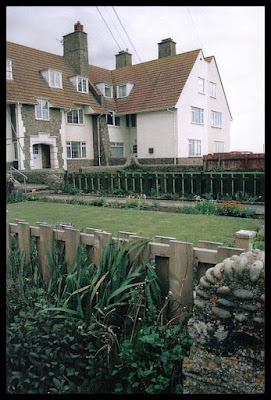Situated by the harbour on Trevelyan Road, this lovely terrace of Edwardian Arts & Crafts houses was built in 1906. Like many towns in Britain there was extensive building at the beginning of the new 20th century, and several building projects took place in Seaton during the first few years. Much of it was promoted by the then Lord of the Manor, Sir Walter John Trevelyan - hence the name of the road - as borne out by his initials on Manor Cottages, another terraced housing project built in the town.
Also, like many local buildings of this time, including Manor Cottages and the Town Hall, they have flint facing along with Romanesque style quoins and edgings to doors comprising alternating long and short stones in limestone...possibly from Beer Quarry above the nearby village of Beer.
A
most unusual thing, that I haven't seen before, are the double roof ridges
between the individual houses. It made me wonder about the collection of rain water as there doesn't appear to be any drainpipes running from that central dip.
As
I live in Seaton, and have walked along this road many times, it didn't
occur to me to take photos of these houses until reading in the Seaton
Design Statement that their garden walls are topped with pebbles and are
reminiscent of Devon Banks (more info below the next photo). As I was
working on a project concerning pebbles used in building I promptly
trotted down here to investigate and take some photos.
Devon
Banks or Hedge Banks are a method of hedging specific to the
South-West, in which banks of earth are strengthened or faced with stone
and hedgerow plants and trees are planted on top. In a nutshell! If
you'd like to read more there's a good downloadable pdf produced by
Natural England here.
I'm not totally convinced they look like - or were meant to look like - Devon Banks, but they are a rather lovely decoration distinctive to the area.
A Watch House belonging to the coastguard was situated where the garden of the end house now is, near to the sea. After the watch moved across the River Axe the building became a tea room, but was eventually demolished in 1904 to make room for the new Trevelyan Road and terrace.
After my first photo shoot I eventually returned to take more photos of the terrace in order to add it to my now defunct website. I never got as far as writing it though, so this article is a brand new one for the blog...and as you can see, there's a marked difference in the photos: a totally different kind of day!
Below, an ancient anchor brought up from the sea set in a tiny park between the end house and the sea wall.
And looking at the rear of the houses where they back onto Axmouth Harbour, below.
A little more utilitarian at the rear but they still make a lovely sillouette in the landscape from the other side of the harbour.
And a few more photos from the front again.
And there we have it! Mind, before I put those last few photos on I had a thought of something else I could say, but once the photos went up I completely forgot what it was. Doh! So I'll add that if it comes to mind and it's interesting enough. ;)






















No comments:
Post a Comment